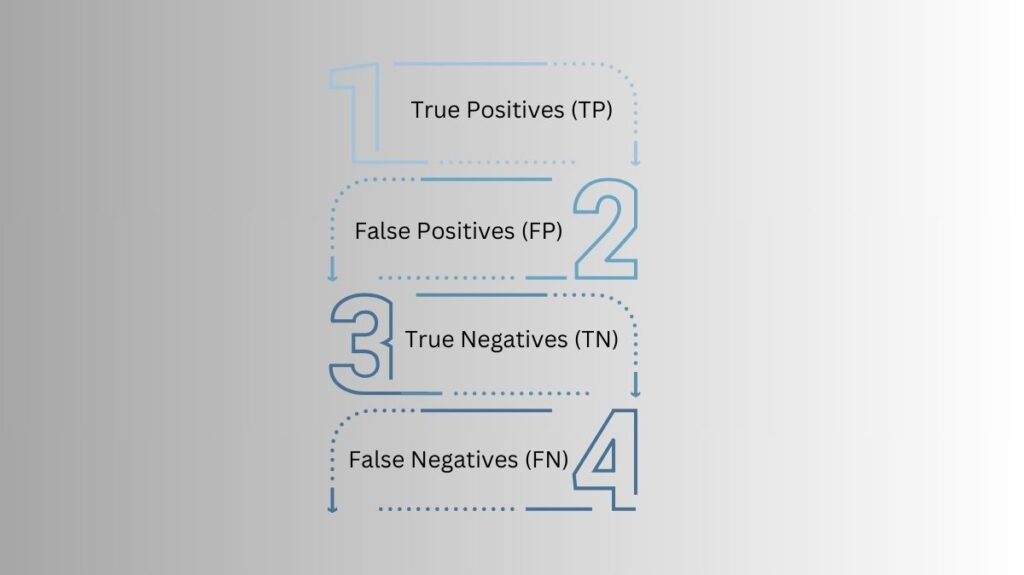A confusion matrix is essential in machine learning, especially classification. By showing correct and wrong predictions, it details model performance. A confusion matrix helps practitioners discover specific model faults by providing a more comprehensive perspective of model performance than a single accuracy score. Let’s discuss confusion matrices, how they function, and their use in evaluating machine learning models, particularly classification jobs.
What is a Confusion Matrix?
Essentially, a confusion matrix is a table used to evaluate a classification algorithm using test data with known true values. The matrix compares actual labels (real values) to model-predicted labels to provide a detailed analysis of correct and incorrect predictions. It simplifies model predictions by showing the types of errors.The confusion matrix in binary classification (where the target variable might be “positive” or “negative”) usually includes four parts:

True Positives (TP): These are the cases where the model correctly predicted the positive class.
False Positives (FP): These are the cases where the model incorrectly predicted the positive class when the actual class was negative.
True Negatives (TN): These are the cases where the model correctly predicted the negative class.
False Negatives (FN): These are the cases where the model incorrectly predicted the negative class when the actual class was positive.
Interpreting the Confusion Matrix
A confusion matrix provides a more detailed assessment of a classification model than an accuracy score. Understanding performance factors like how often a model confuses one class for another helps.
- Accuracy: Accuracy is the percentage of correct predictions. Matrix accuracy may not always tell the whole story. In imbalanced datasets when one class is significantly more common than the other, a model can predict the majority class most of the time with high accuracy even if it fails to recognize the minority class.
- Precision: Precision measures how many projected positives were true. It replies “Of all the instances the model labeled as positive, how many were actually positive?”
- Recall (Sensitivity): How many positives the model detected properly is called recall (sensitivity). Answers “Of all the positive instances, how many did the model successfully detect?”
- F1-Score: The harmonic mean of precision and recall balances their trade-off. In cases when false positives and negatives have varied effects, the F1-score may be more useful than accuracy.
These confusion matrix-derived metrics assess model performance from many angles. Practitioners can choose or improve a model based on precision, recall, and the F1-score to balance false positive and false negative costs.
Why is the Confusion Matrix Important?
The confusion matrix clarifies several key topics for enhancing machine learning models. The model’s errors must be understood as well as its correctness. Reasons for its importance:
- Class Imbalance: Many real-world categorization tasks underrepresent some classes. Accuracy alone can deceive. A medical diagnosis problem may have a rare condition, thus forecasting “no disease” most of the time may nevertheless be accurate. However, the confusion matrix shows how many actual cases of the disease were missed (false negatives) or misinterpreted (false positives), which provides a more practical picture of model performance.
- Model Evaluation: The confusion matrix helps us evaluate models more thoroughly. Instead of just knowing how many correct predictions were made, we observe which errors occurred. A fraud detection system may cost more to miss a fraudulent transaction than to erroneously mark a normal transaction as fraudulent. Practitioners can clearly examine trade-offs with the confusion matrix.
- Error Analysis: Model error patterns can be found by closely inspecting the confusion matrix. If the model frequently misclassifies classes or has large false positives and negatives, this can inform future improvements. It may imply that the model needs more balanced data, alternative characteristics, or different techniques to catch patterns.
- Thresholding and Optimization: The confusion matrix helps tune model decision thresholds. Many models, especially probabilistic ones, output continuous values between 0 and 1 as class probabilities. Based on a threshold, these probabilities must be translated into discrete class predictions (positive or negative). By studying the confusion matrix for different thresholds, practitioners can determine the appropriate precision-recall balance for their use case.
Extending to Multi-Class Classification
When classifying more than two classes, the confusion matrix can be extended to indicate how each class compares. In this scenario, the matrix will be a square grid with rows and columns representing the classes and elements representing the number of times a class was predicted as another class.
In a situation with three classes, A, B, and C, the confusion matrix will show how often the model predicts A when the true class is A, B when the true class is A, and so on for all conceivable combinations. Because distinct classes may have varying classification difficulties, calculating precision, recall, and F1-score for each class is significant.
Visualizing the Confusion Matrix
The confusion matrix simply a table, however heatmaps can help identify patterns and assess model performance. Visual representations help identify the bulk of errors in multi-class classification scenarios.
Practitioners can immediately determine if the model is having problems identifying classes by utilizing colors to represent high and low matrix values. This visual tool is invaluable for immediately diagnosing performance issues and leading model modifications.
Conclusion
The confusion matrix is essential for classifier evaluation. It provides more information about model mistakes than a mere accuracy score. Tasks where misclassification is more costly or destructive may require this. Understanding precision, recall, F1-score, and other metrics with the confusion matrix helps practitioners improve machine learning models more thoroughly.
In real-world applications where false positives and negatives can have serious repercussions, the confusion matrix and its derived metrics help optimize the model to match specific objectives. Understanding and using the confusion matrix is essential to constructing a reliable, high-performance model for medical diagnosis, fraud detection, or other classification tasks.
